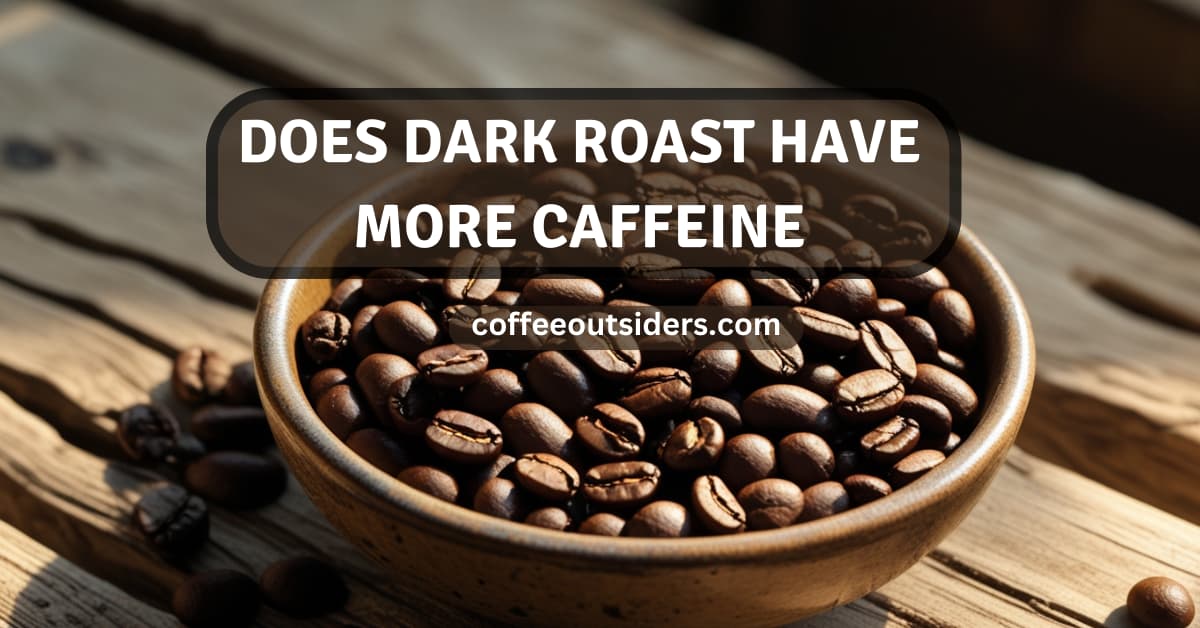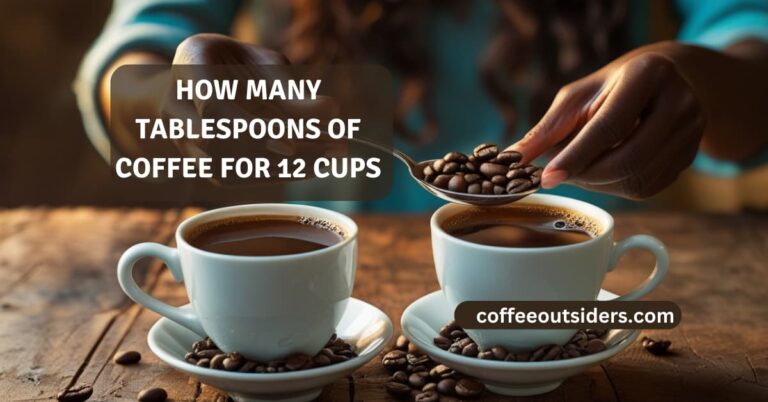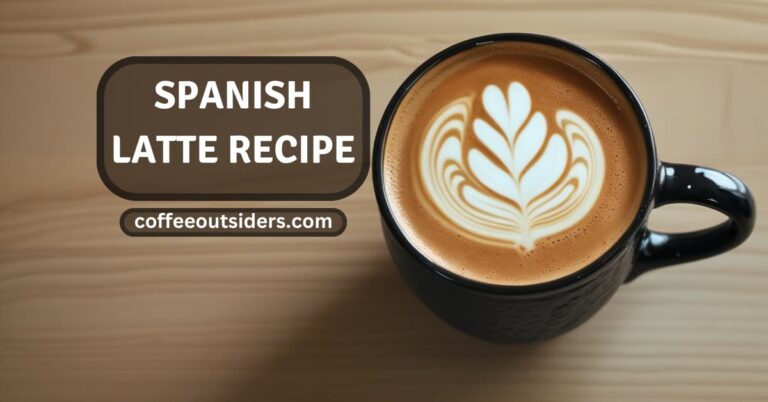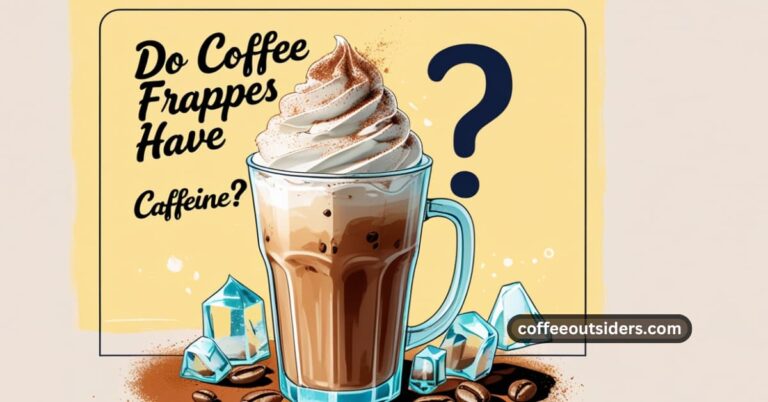Does Dark Roast Have More Caffeine Than Light Roast?
It’s a common misconception that dark roast coffee has more caffeine because it has a stronger taste, but this isn’t true. Caffeine content is all about how you measure your beans, not what roast they are.
When you measure caffeine levels by weight, they’re roughly equal in all roasts. When measured by volume, light roast has a bit more caffeine due to the beans’ denser makeup.
Knowing these facts will allow you to select the roast type that suits your tastes without any caffeine confusion.
- Dark roast coffee isn’t higher in caffeine than light roast when measured per weight. Caffeine content is virtually the same no matter the roast type.
- The only way to get an accurate caffeine comparison is to measure coffee by weight. Because light roast beans are denser, they might have a very small edge in caffeine per volume over dark roasts.
- Just because dark roasts taste stronger and more bitter doesn’t mean they have more caffeine. Flavor intensity is determined by roasting, not caffeine content.
- In fact, the type of coffee bean, brewing method, and serving size have a much greater impact on caffeine content. In reality, the brewing variables are far more important than roast level.
- Caffeine content of Arabica and Robusta coffee beans differ greatly, with Robusta having almost twice as much caffeine as Arabica.
- Ultimately, selecting the right roast is about finding a balance between flavor preferences, caffeine tolerance, and daily routines to enhance one’s coffee experience.
Does Dark Roast Have More Caffeine

1. Understanding Roast Levels and Caffeine
Roast levels, ranging from light to dark, significantly influence a coffee’s flavor and aroma profile. Light roast coffees often exhibit more fruity or floral notes, while dark roast coffee beans create intense, smokier flavors. These variations in flavor arise from the amount of heat the roasted coffee beans are exposed to during the roasting process.
Interestingly, the roasting process has a negligible effect on the overall caffeine levels. While other compounds may dissipate or transform as the beans darken, caffeine remains remarkably heat-resistant. This means that the caffeine content in both light roast and dark roast coffee remains relatively stable.
Moreover, roasting alters the physical characteristics of coffee beans. Lighter roasts are denser, while dark roast beans expand and lose moisture, resulting in a lighter and less dense product. A medium roast coffee will weigh less after roasting compared to its raw form, yet it maintains a balanced caffeine level.
This difference in density greatly impacts how coffee is measured and how much caffeine people perceive they are consuming. Although a dark roast brew has a strong, bitter flavor that suggests a substantial caffeine punch, this is a common coffee myth — it does not actually contain more caffeine than lighter roasts.
2. Comparing Light and Dark Roasts
| Roast Type | Caffeine Content (Per Weight) | Flavor Notes | Bean Density |
| Light Roast | Slightly higher per volume | Fruity, floral, acidic | Denser |
| Dark Roast | Similar per weight | Smoky, bold, bitter | Less dense |
When you measure coffee by weight, light roast coffee has more caffeine, but it’s not that simple. That’s as a result of the denser beans of light roast squeeze more caffeine into the same volume. If you measure your coffee by weight, dark roasts will come out on top in caffeine content.
In a 0.7-ounce serving, dark roasts can have as much as 1.7% caffeine, whereas light roasts have around 1.4%. This discrepancy is due to the fact that dark roast beans are larger, but less dense, so fewer beans will fit into the same scoop on average.
Brewing methods play a big role in how much caffeine is extracted, too. A pour-over method or auto-drip machine will generally extract caffeine better than shorter brewing methods such as espresso. Though darker roasts might extract as high as 95% of their caffeine, lighter roasts generally only extract about 92%.
These numbers illustrate negligible differences that most drinkers wouldn’t even notice. They point out that’s not the whole story, including how brewing can quietly affect the caffeine concentration in your cup.
3. Common Myths About Caffeine in Roasts
One widespread misconception is that the darker the roast, the higher the caffeine content. This belief arises from the strong, bitter taste of dark roast coffee, which many coffee lovers associate with more energy-boosting effects. However, studies show that caffeine content remains almost exactly the same across varying roast levels when measured by weight, as roasting doesn’t alter caffeine molecules.
Another common myth is that to get the most caffeine possible, one should always opt for dark roast coffee over lighter roasts. While dark roast beans can have a slight edge in caffeine if weighed, the difference is negligible for the average drinker.
Relatedly, another misconception is that if you want the most caffeine possible, you should always choose dark roast coffee over lighter roasts. Darker roasts can win out ever so slightly in caffeine if weighed, but the amount is insignificant for the average consumer.
It’s also widely believed that Arabica coffees contain less caffeine than Robusta, but Arabica can reach up to 2.4% caffeine by volume once roasted, depending on the variety.
This serves as a useful reminder that the type of coffee bean and its preparation are what truly matter, rather than just the roast level, especially for those seeking a substantial caffeine punch.
Ultimately, understanding these nuances can enhance the coffee experience for caffeine connoisseurs and casual drinkers alike.
Factors Influencing Caffeine Content
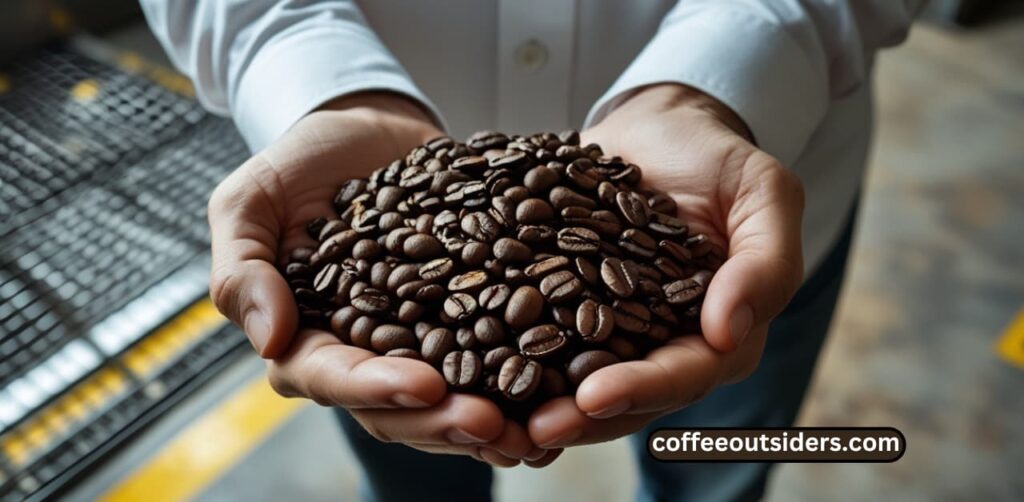
1. Coffee Bean Varieties and Their Impact
When it comes to total caffeine content, the type of coffee bean significantly influences the caffeine levels. The two main varieties, Arabica and Robusta, vary dramatically in their natural caffeine content. Robusta beans are known for having nearly double the caffeine punch compared to Arabica beans, making them a preferred choice for those seeking a substantial caffeine boost.
For instance, a cup brewed with Robusta beans can deliver a much higher caffeine volume, while a brew made with Arabica beans offers a gentler caffeine kick. This choice of bean truly impacts the caffeine landscape and overall flavor experience.
If you’re a coffee lover who enjoys a more mellow flavor, Arabica beans are ideal. They provide a balanced caffeine level, delivering just enough caffeine to ensure a steady energy boost. On the other hand, for those wanting an intense flavor and a caffeine punch, Robusta might be the way to go.
Interestingly, a light roast Robusta will typically contain more caffeine than a dark roast Arabica. This common coffee myth about darker roasts being more caffeinated highlights the importance of understanding the characteristics of coffee beans beyond just their flavor profile.
2. Brewing Methods and Caffeine Extraction
Along with these factors, brewing methods are incredibly influential on how much caffeine actually makes it into your cup. Not all methods extract caffeine evenly, mainly due to things like water temperature, brewing time, and pressure.
Cold brew coffee comes from a special steeping method where coffee grounds sit in 40 degree water for long periods of time – usually 12+ hours. This natural process can lead to significantly higher caffeine content. That’s because the extended steeping time helps draw out additional caffeine — even at cooler temperatures.
This is because hot brewing methods, such as drip coffee and espresso, extract caffeine quickly. This occurs due to the fact that caffeine is highly soluble in hot water. Caffeine is very soluble at 100 °C (212 °F), greatly increasing its extraction rates.
For best results, brew drip coffee for 4 to 5 minutes. Conversely, espresso is aided by pressure and it only takes 20-30 seconds for optimal caffeine extraction. Both methods provide a fast and convenient way to consume a caffeinated beverage.
3. Serving Size and Its Role in Caffeine Intake
Serving size is an obvious but important consideration when it comes to caffeine intake. A typical 8-ounce cup of coffee contains around 95mg of caffeine. This is the case for light and dark roasts alike.
The amount of caffeine ingested does rise with increasing serving size. For instance, it would only take a 16-ounce cup to quickly double that, up to about 190 milligrams. Larger cup sizes, or just more caffeine.
Whatever you decide, be aware of your caffeine consumption! This is especially relevant for those using oversized mugs or frequenting coffee shops, where a “grande” or “venti” serving can pack considerably more caffeine.
Being mindful of portion sizes allows you to get the most enjoyment—and caffeine—out of every sip.
Characteristics of Different Roast Levels
Understanding the characteristics of different roast levels helps uncover how roasting impacts flavor, aroma, caffeine content, and overall coffee experience.
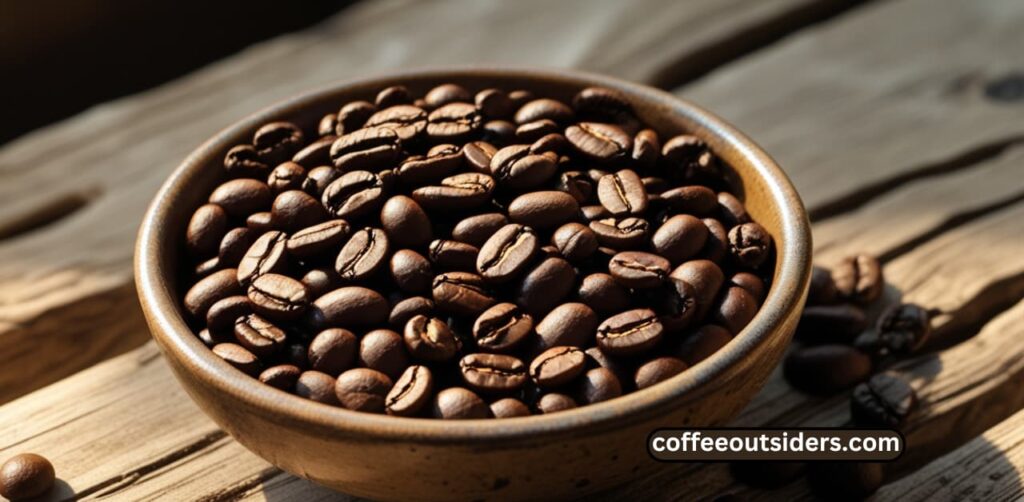
Whether you prefer a light, medium, or dark roast, each level provides a distinct set of characteristics to suit every taste.
Light Roast and Its Features
Light roast coffees are particularly known for their bright and vibrant flavors, sometimes described as mild and refreshing. This roast level maintains a lot of the coffee bean’s natural characteristics due to an internal roasting temperature of 350-400°F, making it a favorite roast among coffee lovers.
A lighter roast profile is often referred to as the more “true” representation of the coffee bean’s flavor. This can range from floral to fruity notes, or even herbal undertones, luring in the crowd who loves an elegant and complex taste. Many coffee enthusiasts appreciate the balanced flavor that light roasts offer.
Perhaps the most striking characteristic of light roasts is their increased acidity. This acidity, often described as a tingly or sharp feeling on the tongue, adds depth to the overall caffeine levels of the coffee’s taste.
A light roast using Ethiopian beans can explode with lemon or blueberry flavors, resulting in a colorful and vibrant cup of coffee. This unique profile makes it a popular choice among caffeine connoisseurs.
Light roasts will have a bit more caffeine in them by weight because they come from a denser bean structure. This roast style packs a serious caffeine punch with up to 450 milligrams of caffeine in each 1/2 liter brewed cup, appealing to those who enjoy a substantial caffeine kick.
You’ll notice the difference immediately after the first sip! Coffee enthusiasts love light roasts because of the transparency they provide, highlighting the coffee bean’s origin and individual characteristics.
Medium Roast and Its Properties
Medium roast coffees provide a great middle ground between the brightness found in light roasts and the bold, rich flavors associated with dark roasts. Characterized by a balanced taste, medium roasts feature a moderate level of acidity complemented by a slight richness.
This gives them a friendly quality that’s very appealing to all types of coffee drinkers.
The medium roasting process usually ends with the beans at about 400-430°F. This gives the beans more time to develop richer, complex flavors, while preserving some of their unique qualities.
Medium roasts usually bring out caramel or nutty notes, creating a balanced, smooth, and rich cup of coffee.
Their moderate acidity makes medium roasts particularly adaptable to different brewing styles, from drip coffee machines to French presses. A Colombian medium roast provides a fantastic combination of chocolatey sweetness and zesty citrus.
It’s a sure hit with coffee drinkers from every walk of life—from the casual drinker to the coffee connoisseur.
Dark Roast and Its Unique Traits
We roast our dark roast coffees to bold, smooth, rich perfection. These beans are roasted for a short time at a higher temperature, usually between 430-450°F, cooking through to, or even past, the second crack.
This deeper roasting process blends the beans’ natural flavor profile. Rather, it amplifies the smoky or lightly burnt flavors that so many consumers associate with traditional dark roast profiles.
Dark roasts have less acidity than lighter roasts, giving them a more rounded, smoother drinking experience. Yet they often carry a more intense bitterness, a byproduct of the roasting process.
If you like a strong, robust flavor, then dark roasts are the perfect choice. French roast, Italian roast, and espresso roast are popular examples, producing a strong, full-bodied brew.
Dark roasts have the most caffeine, with up to 490 milligrams per 1/2 liter brewed cup. Though a bit more so than light roasts, the contrast is nuanced.
So dark roast lovers crave the bold and bolder flavors. Whether they enjoy it in a rich, creamy beverage, or as a strong, black coffee, they’re sure to appreciate every sip.
How Roasting Affects Caffeine Levels
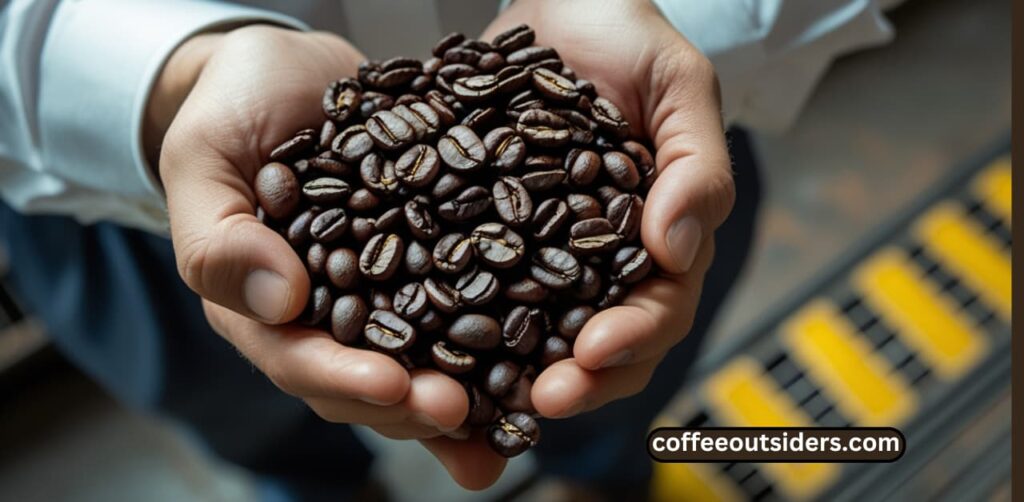
The Science Behind the Roasting Process
When coffee beans are roasted, they undergo significant chemical and physical changes, leading to the creation of aromatic, complex roasted coffee beans. These transformations give us the complex flavors and aromas we crave in our coffee, making up your delicious morning brew. The process turns dense, grassy green coffee beans into a delightful coffee drink that many coffee lovers enjoy.
The Maillard reaction plays a crucial role in this transformation, as it is a vibrant chemical reaction between amino acids and sugars. This reaction produces the deep, caramelized flavors that we crave in roasted coffee, starting around 300°F and continuing throughout the roasting process. This results in nuanced taste profiles that coffee connoisseurs are passionate about.
Even under such extreme heat, caffeine molecules remain remarkably stable compared to other compounds. Research shows that almost no caffeine is lost during the roasting process, despite beans getting darker and flavors becoming bolder. Thus, the overall caffeine levels in light and dark roast coffee are virtually the same when measured by weight.
This means that whether you prefer a lighter roast coffee or a dark roast brew, the caffeine potency remains consistent, allowing you to enjoy your favorite coffee without worrying about significant differences in caffeine content.
Heat’s Impact on Caffeine Retention
Even at such extreme temperatures, commonly over 400°F, there’s relatively little change in caffeine retention. Longer roasting times do have a small impact, decreasing caffeine content. The truth is that these losses are inconsequential for the average coffee drinker.
The sweet spot is roasting long enough to bring out flavors you love while still not having a huge impact on caffeine. Darker roasts tend to pack more of those bold, smoky notes. By weight, their caffeine levels can still be similar to those of lighter roasts.
Ironically, darker roasts tend to have a higher extraction rate when brewed. All else being equal, dark roasts do have a touch more caffeine than light roasts, cup for cup. This difference is primarily due to their solubility.
The difference might be negligible, but it serves to underscore the relationship between preparation method and roast level. This interaction has a major impact on the final caffeine content. For the average consumer, the difference is too nuanced to detect in their day-to-day intake.
Volume vs Weight in Measuring Roasts
This approach will guarantee that all of your roasts have the same amount of caffeine per given weight of coffee. Measurement by volume, like scoops, can cause discrepancies as darker roasts tend to be less dense.
Because light roast beans are denser, they pack more caffeine per scoop than darker roasts. Coffee lovers who want to know exactly how much caffeine they’re drinking should invest in a kitchen scale to get it right.
By understanding these factors, coffee drinkers can better understand how roasting affects their cup and how they can enjoy great coffee without drastically affecting caffeine levels.
Choosing the Right Roast for You

Match Roast to Your Daily Activities
The process of choosing the right coffee roast for you usually begins with knowing how it best serves your everyday life. Lighter roast coffee is great for those looking for a gentler way to wake up in the mornings. Roasters typically describe these as having a more mellow taste and a bit more caffeine per weight than their darker counterparts. Instead, they provide a mild nudge to help set you in motion.
You don’t need to give up drinking an excellent, balanced cup! If you’re preparing for a morning loaded with non-stop meetings or lectures, try a light roast. It’ll wake you up but won’t assault your palate.
Darker roasts are best in the afternoon or evening. They bring a deep, vigorous taste that most coffee enthusiasts desire. Darker roasts may have slightly less caffeine due to the roasting process. They do provide lots of robust flavor that pairs wonderfully with more slow-burning pursuits like reading or unwinding after a long day at work.
If you’re tackling all-day chores or burning the candle at both ends on homework, a medium-dark roast will be your new BFF. It provides a deliciously convenient boost that helps you stay focused, and it can be a great option for those with moderate caffeine tolerance.
Or, if you have an especially high-energy day coming up, you may want a roast with a bit more caffeine content to keep you going. Yet if you’re more interested in the taste value or calming qualities, a deep roast might be perfect for you. When you choose your roast according to your plan, you can ensure that your coffee is a smooth, natural extension of your day.
Consider Your Personal Caffeine Tolerance
Another important consideration in roast choice is caffeine tolerance. Everyone’s tolerance is different, so it’s key to determine how much caffeine you’re willing to consume. If you’re sensitive to caffeine, beginning with lighter roasts is a good place to start. These darker roasts have more caffeine per weight because the roast process creates a denser bean.
Their effects are strong but smooth and pleasant to consume. Quality Arabica beans in a light roast provide the highest caffeine content, ranging from 0.9% to 1.5%. If you like a mild cup, this is a great choice! If you find that even a small amount of caffeine affects your sleep or energy, opt for smaller portions.
You might even want to check out some decaf roasts to get an even smoother experience. Even brewing methods can make a difference in how much caffeine you drink. Espresso shots actually have less caffeine per ounce than a regular 8-ounce cup of coffee. Which is why it pays to consider how you’re making coffee!
Of course, moderation is key here too. Experts suggest capping daily caffeine intake at 400 milligrams, roughly equivalent to four 8-ounce cups of coffee, to maintain good health. Learning to listen to the reactions in your body will help you identify the roast that is the best fit for your tolerance and taste.
Balancing Flavor Preferences with Caffeine Needs
Achieving a balance between flavor and caffeine content will take your coffee to the next level. Medium roasts, like the ones we use at Agitator Coffee, are right in the sweet spot between the lighter end and the darker end of the spectrum. These beans are roasted slightly beyond the first crack to obtain a medium brown color with a light sheen of oil.
They provide a flavor profile that is smooth yet rich. They’re an excellent option for those who still want a full-bodied flavor without all the caffeine. Try different roasts to find the perfect blend for you. If you like an extra strong caffeine buzz, Robusta beans are for you.
They typically have a higher caffeine content than their Arabica counterparts, so they’re ideal for those looking for a little boost. Or, if flavor is the most important factor, Arabica beans are praised for their subtlety and complexity. Brewing methods can further adjust your coffee.
Brewing in a French press enhances the body and flavor of darker roasts. Pour-over techniques really highlight the brightness in the lighter roasts. Your taste will change as years go by. Trying different roasts and brew methods can help make your coffee experience fun and exciting!
Conclusion
Here’s the thing—caffeine content is affected by a lot of factors. It’s possible that dark roasts seem like they deliver more flavor bang for our buck. They typically have a bit less caffeine per scoop than lighter roasts. Bean type, brewing method, and whether you measure by weight or volume are important factors, too. Each roast has its own distinct flavor profile. Savor the fruity acidity of a light roast or plunge into the intense richness of a dark roast!
Ultimately, choosing the right roast is a matter of personal preference and the flavor profile you’re looking for in your coffee. Experiment with different options to find the one that works best for you. In the end, coffee should be something you enjoy, so drink what you like. Whatever you do, just try something new, and make sure to enjoy the journey of discovering your perfect cup.
Frequently Asked Questions
Myth: Dark roast coffee has more caffeine than light roast coffee. In fact, light roast coffee typically contains a greater caffeine percentage. This is because it is roasted for a shorter time, preserving more of its inherent caffeine and providing a substantial caffeine punch.
Light roast coffee often contains more caffeine compared to dark roast coffee, which loses some caffeine during the roasting process; however, the serving size typically has a greater impact on total caffeine content.
Dark roast coffee offers a bold flavor profile, which many coffee lovers appreciate. However, this intense flavor does not necessarily indicate a higher caffeine content; it’s the roasting process that influences the overall caffeine levels.
Acidity Yes, darker roasts, such as dark roast coffee beans, are more acidic. The roasting process breaks down acidic compounds, making dark roast brews smoother and less tangy than lighter roast coffee.
Caffeine content varies based on the type of coffee bean, brewing method, grind size, and serving size used. While the roast level, whether it be dark roast coffee beans or lighter roast coffee, adds to the overall flavor, it has less impact on caffeine potency than these other factors.
Order a light roast coffee for an extra caffeine punch. Though the difference is minimal, light roast coffee typically contains slightly more caffeine than dark roast beans.
Consider what you desire in terms of flavor and caffeine potency. If bold flavors with low acidity appeal to you, dark roast coffee beans are the ideal choice. For a bolder, more acidic flavor and an extra caffeine kick, opt for lighter roast coffee.

